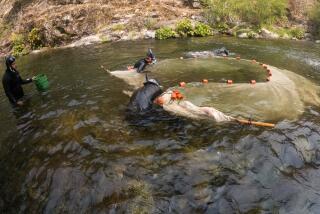Saving Lake Mead’s Bass : Fertilization Project Is Intended to Stop the Decline in Game Fish Numbers
- Share via
Sometime next June, an armada of 250 to 300 bass boats will gather on Lake Mead. But for once, the fishermen in the boats will be putting something into the lake instead of taking something out.
In a fertilization project believed to be more ambitious than any other ever attempted on a body of water in the United States, about 100 tons of fertilizer will be spread over 30,000 acres of the lake’s Overton Arm and 11,000 acres of Gregg Basin in an attempt to reverse Mead’s declining sport fishery.
The project, which has already been tested successfully on Mead, involves treating the lake with ammonium phosphate, normally used to fertilize lawns, in hopes of reversing the decline in the lake’s phosphates, which are critical to its food chain.
Said Larry Paulson, director of the University of Nevada Las Vegas’ Limnological Research Center: “Trying to grow game fish in a lake without phosphates is like trying to grow cows on a tennis court. It just doesn’t work.
“Before 1963, Lake Mead’s largemouth bass fishing was as good as anywhere in the United States. But with the completion upstream (on the Colorado River) of Glen Canyon Dam, the natural flow of phosphates into Mead was interrupted. And the decline of largemouth and striped bass fishing in Mead has steadily gone downhill ever since. This project, we think, will help reverse that.”
Volunteers in the bass boats will drag fine-mesh polypropylene bags filled with granular ammonium phosphate across the surface of Overton Arm, a region of the lake particularly hard hit by the two-decade decline in phosphates.
“Ammonium phosphate, as it diffuses in the water, will heighten the growth of algae, which produces an increase in zooplankton (microscopic animal life), which is the principal food of threadfin shad, which are the lake’s only forage fish for largemouth and striped bass,” Paulson said.
“Right now in Mead, in the stomachs of striped bass, you can sometimes find zooplankton. That’s bad news, anytime you have big game fish like that dipping down that far in the food chain. They should be eating shad.
“In our test fertilization of Cathedral Cove in August, we put in 2,000 pounds the first time, then 5,000 pounds a week later, over about 50 acres of water. In two days, we had a three-fold increase in algae production in the area we fertilized. We monitored the fertilization area for two weeks and the tests were very successful.”
Paulson said that such artificial fertilizing of Mead’s waters would have to be done regularly to maintain or build upon improvements in the game fish.
For years, Mead fishermen have complained about a declining population of largemouth bass and about skinny, stunted or deformed stripers. One biologist believes the fertilizing will at least produce better-looking fish.
“What we think we’ll see is game fish with better body condition, healthier looking fish,” said David Buck, fisheries biologist for the Nevada Department of Wildlife.
“Our hope is the project will improve or even eliminate cases of poor body condition by increasing the forage base for the shad.”
Catch counts kept by the Nevada Department of Wildlife show a steady decline in fishing quality at the 30x50-mile lake since 1963. The average largemouth bass catch by an angler for one day in 1963 was just under three. By 1982, it was less than one.
A 1983 study published by the UNLV Limnological Research Center--limnology is the study of properties of fresh water--linked declining phosphate levels into Mead with the decline in algae production. After the 1963 completion of Glen Canyon Dam, which impounds Lake Powell, phosphates--leached from rocks in the Colorado River drainage area--settled upstream in Powell instead of flowing downstream to Mead.
Until the mid-1970s, Mead had a second source of phosphates--the Clark County advanced waste water treatment plant. Treated water from the plant, 10 miles from Mead, carried phosphates into the lake through Las Vegas Wash. But stiffer environmental laws forced plant operators to greatly lessen phosphate levels in its effluent water, resulting in a flow of nearly distilled water into the lake.
The areas to be fertilized will affect only Upper Basin areas, Paulson said, and the operators of the waste water treatment plant are being asked to relax wintertime phosphate effluent levels.
Raising the phosphate level of Las Vegas Wash water could have far-reaching, positive effects on game fish populations in wider areas of Lake Mead, Paulson said.
The fertilization project will involve the Nevada Department of Wildlife, the Arizona Game and Fish Department, the U.S. Bureau of Reclamation, the Environmental Protection Agency and the National Park Service.
More to Read
Sign up for Essential California
The most important California stories and recommendations in your inbox every morning.
You may occasionally receive promotional content from the Los Angeles Times.










